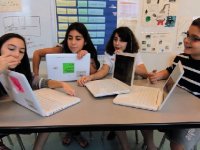Using Multimedia Technology for Teaching Social and Life Skills
Take a good story, make it into an illustrated book, develop a curriculum, shoot videos of kids in action, add a website, create an app, ground it all in rigorous research and this may be the formula for the next wave of social and life-skills-related instruction.
The story is inspired by the situation faced by so many children who lead lives of considerable physical and psychological challenge and trauma but persist and become resilient finding greatness in their lives. In the book that anchors this program, Born for Greatness: Me, You, and the Dalai Lama, By Bouncy the People Trainer, readers are introduced at the end to Bonnie St. John, a woman who overcame abuse and physical handicap to learn to ski, attend college, win a Paralympics medal, and meet the Dalai Lama.
Bouncy the People Trainer, the titular author, is the star of the show. Bouncy is a small dog that had an abusive owner and grew up with only three legs. The story shows how Bouncy survived, was mentored, and realized that Bouncy's true greatness is as a "people trainer" -- someone who "trains people to be strong and smart and kind." Bouncy learned about and reflected on the story of the Dalai Lama, who also grew up under difficult circumstances and had to find his way to greatness, despite many doubts along the way.
Building Social-Emotional Skills
So the illustrated book introduces us to Bouncy, and then there is a hand-off to multimedia designed to assist parents, teachers, and children in building the social-emotional competencies of kids aged 4-9, approximately. There is an app designed especially for parents that can be downloaded at no cost (for the iPad only).
The app, "You Can Learn," allows children to choose a multicultural avatar, and has learning segments that include children learning the same lessons as Bouncy, "Kids Show," with engaging videos of young children showing how they use skills to handle situations while talking/thinking aloud about what they are doing. There's a set of "What If?" scenarios for real-life interactive problem solving, "You Star," where the child's avatar joins Bouncy in an animated adventure, and, respecting the multiple intelligences, segments that uses art, music, sing alongs, and games to build skills. Another terrific feature is "Ask Bouncy," where kids can pose questions about social skill issues and get answers.
Grounding in Theory and Research
The creators of Bouncy are steeped in social-emotional learning theory and research and provide this background to anyone who is interested. They have extensive experience in using computer-based training but see the iPad (and similar media) as providing ground-breaking opportunities for parents and educators to combine their goals in building children's SEL skills. They tuned in particularly to the research that shows the particular importance of helping children deal with obstacles to their problem solving.
Long before the term, "grit," came into prominence, the literature showed that helping students overcome obstacles was the key to generalizing social skills-type training into the real world.
Why? The strong emotions that result from setbacks can dampen one's belief in one's own problem solving abilities. This sets off a kind of vicious, self-fulfilling cycle that erodes confidence, which then limits opportunities, and makes failure even more likely. That's why Bouncy needed help from a master dog trainer to believe in a new set of possibilities. And that is why Bouncy wants to be that source of inspiration to kids. As Bouncy says, "Some people train dogs. I'm a dog who trains people."
Of course, Bouncy is more of a guide than a "trainer," and the developers of this multimedia system realize that parents and others using the app may benefit from guidance in doing so. Their support is abundant and accessible, reflecting a long history of understanding the strengths and challenges of computer-based instruction.
It's early in the life of Bouncy, but the combined use of print, video, and digital media, backed up by support and documentation, crafted in a way that leads to considerable personalization, and rooted in both research and sophisticated modeling of human problem solving that allows for sophisticated but developmentally appropriate examples and activities moves the work of building children's social-emotional skills to a new plane. And its accessibility to parents, albeit only via the iPad at this point, allows for greater parent-school collaboration than has previously been the case.
The goal of helping more children believe they are born to greatness, and to build the skills needed to live that belief, is a goal many in the SEL, character development, and related worlds share. It's exciting to see the presence of a new, accessible tool to help in that goal. Future evaluations of Bouncy -- which will likely continue to evolve -- will be important to guiding its ongoing use.
What are your thoughts and ideas on this post? Please share in the comments section below.
